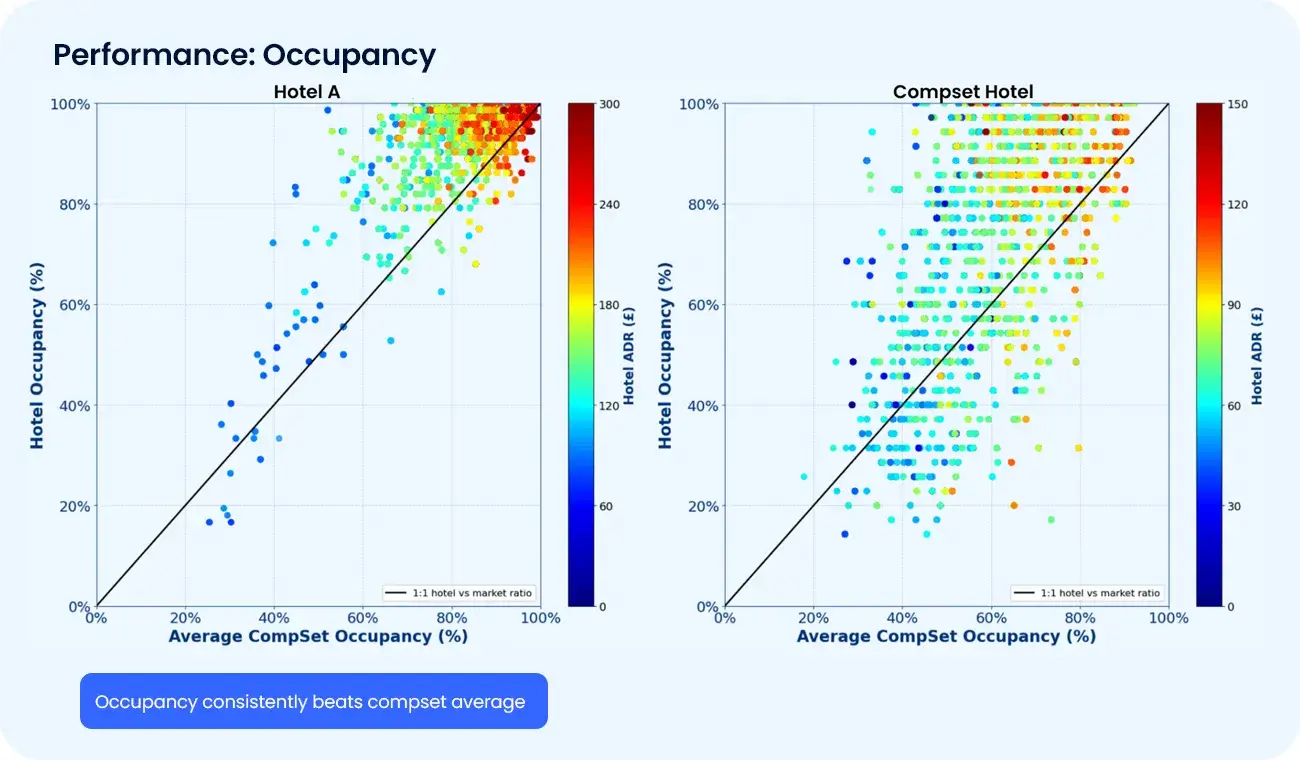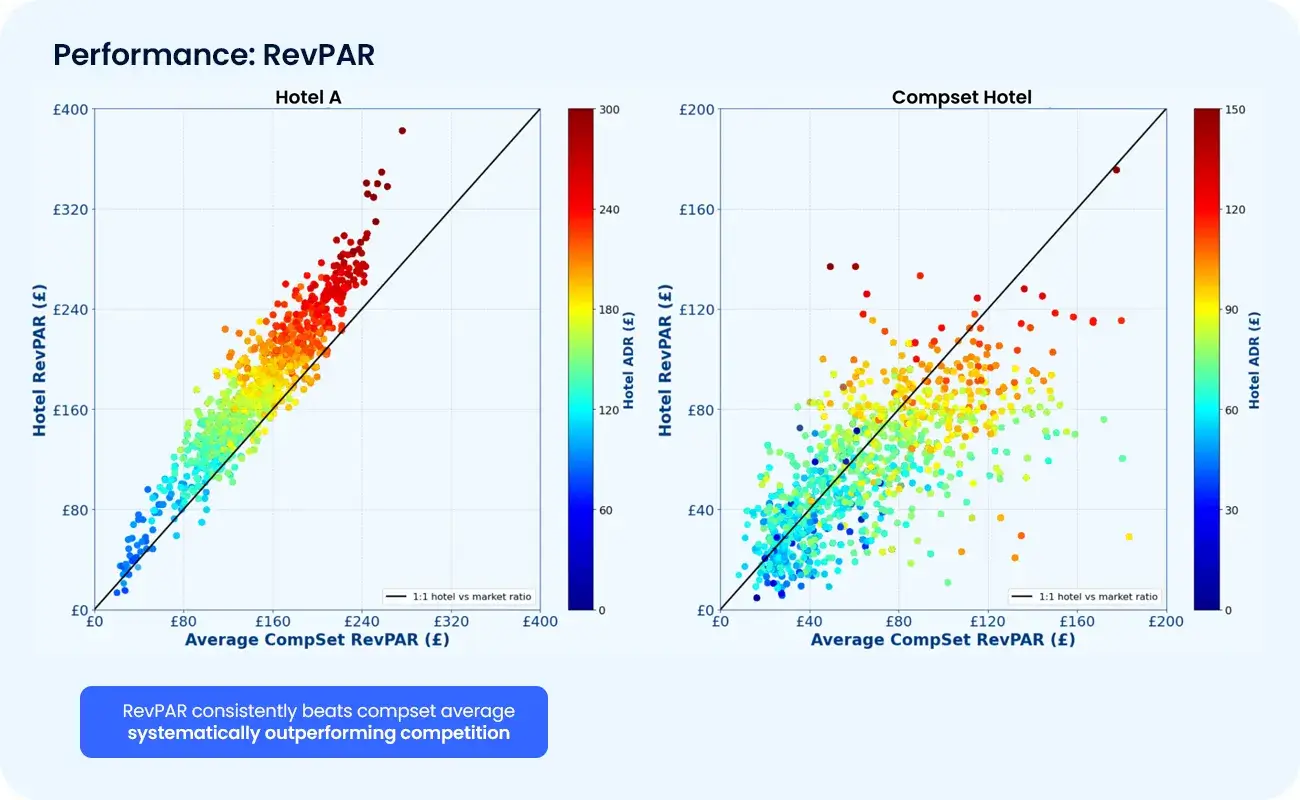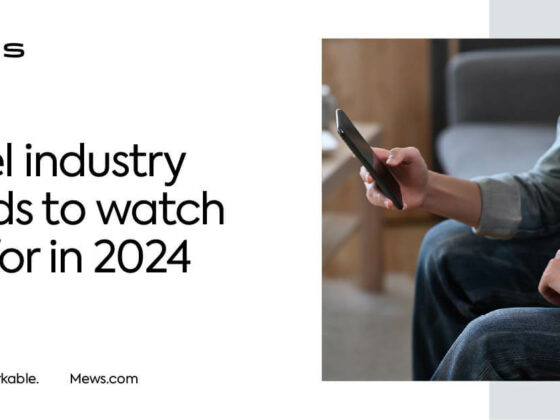One of the main challenges for hotels is creating accurate forecasts in the short, medium, and long term. Understanding future demand trends, their causes, and the guest segments driving them can help hotel revenue managers adjust room rates to boost occupancy and sales.
Accurate forecasting also benefits hotels’ bottom lines in other ways. Managers can use it to budget, allocate resources, streamline inventory management, and improve the guest experience.
But traditional forecasting models no longer cut it. Relying on historical data hinders performance since no season is ever identical to the last. Demand is constantly influenced by new factors, which past data alone cannot predict.
In this article, we explore the evolution of hotel forecasting and how hotels can become more proactive with modern forecasting techniques.
How forecasting is done today
Here, we can visualize a typical revenue management forecasting scenario that relies on historical data.
Say a hotel anticipates higher demand during the first week of July, when a local jazz festival takes place, and plans to increase rates based on data from last year. However, the festival has since gained popularity, moving to a larger venue and featuring higher-profile musicians. This is likely to attract a larger, more diverse crowd from across the country and abroad.
To capitalize on the higher demand, the hotel could increase rates compared to the previous year without risking occupancy and even hold back some rooms from early sales, releasing them closer to the date when rates are likely to be at their peak.
Unfortunately, with a traditional forecasting model, the revenue manager would likely only notice the surge in demand when it’s already underway, missing key opportunities to adjust rates and capture additional revenue from the outset.
FREE GUIDE
Uncover revenue management strategies to take your hotel to the next level in 2025.
Limitations of traditional hotel forecasting
There are two limitations of traditional forecasting in the hospitality industry leading to this situation.
1. Lack of integration between rates and bookings
In standard demand models, rates and bookings are managed separately. This disconnect means that any change in demand trends isn’t immediately visible to the pricing system, which continues to rely on historical data.
The result is a static forecasting approach that often skips directly to the final outcome without evolving predictions through the booking window. With no dynamic adaptation, traditional models lack the flexibility to adjust as new market conditions arise.
Going back to our example, once the forecast was updated and the hotel noticed a surge in demand compared to last year’s event, rooms had already been booked at lower-than-optimal rates, leaving revenue on the table.
2. No use of external or forward-looking data
Traditional models don’t incorporate external data—such as compset rates and benchmarks, the hotel’s ranking on online travel agencies (OTAs), and search traffic from partners—to process it into a unified framework alongside rates and bookings.
This forward-looking data (e.g., current data indicating a larger trend) would enable the revenue manager to recognize the stronger demand generated by this year’s festival before it results in an uptick in bookings. External data is an untapped resource for hoteliers, who usually have access to it but are not able to properly process it and incorporate it into their forecasts.
As a result, revenue managers are forced to rely on guesswork to fill these gaps, leading to biased predictions, missed opportunities, and lost revenue.
How other industries are forecasting
Other industries have moved beyond these limitations by adopting advanced algorithms that dynamically adapt to new conditions, improving forecasting accuracy. These models use machine learning and causal AI to incorporate past and present data and uncover cause-and-effect relationships between variables, predicting shifts in demand and adjusting as they happen.
Airlines analyze booking pace, seasonality, historical demand, competitor pricing, and customer behavior to predict demand levels at various points in time before departure. If demand for a flight is forecasted to be high during peak season, dynamic models may set higher initial prices.
As the departure date nears, the models continuously update pricing strategies based on current booking trends and competitors’ prices, raising or lowering rates to maximize revenue.
Online retailers like Amazon use forecasting algorithms that analyze historical purchase patterns and real-time data, such as seasonal demand, competitor prices, and current stock levels, to adjust product prices and inventory.
For instance, if there’s a surge in demand for a popular toy, the forecasting system immediately updates projections, prompting the company to increase stock levels or adjust prices accordingly.
Similarly, Uber’s AI-powered predictive model continuously analyzes factors like traffic, weather, time of day, and historical demand patterns to forecast where demand will spike in specific areas.
When demand for rides in an area exceeds the number of available drivers, Uber’s algorithm increases rates to encourage more drivers to move to that location and balance supply and demand.
The evolution of hotel demand forecasting
The hotel industry has been somewhat of a laggard, but due to the amount of available data, it has immense opportunities for advanced forecasting methods. A paper published in Tourism Management highlighted just how much valuable insight lies within hotel data.
The study analyzed booking data of U.S. hotels using dynamic mathematical models and found out that guests booking for a Monday or a Wednesday stay are likely to make their reservations closer to the arrival date, with a noticeable increase in bookings in the last few days. Additionally, guests booking for a Wednesday typically reserve slightly earlier than those booking for a Monday.
With this insight, hotel managers might keep Monday rates steady or slightly lower early in the booking window to encourage early reservations, then raise them closer to the stay date to capture last-minute demand. Conversely, for Wednesday bookings, it could be more effective to increase rates slightly earlier in the booking window and adjust them less aggressively closer to the stay date to attract more last-minute bookings.
These powerful insights add up and can have a significant impact when dynamically incorporated into a hotel’s revenue management strategy. The more accurately a hotel can forecast and proactively prepare, the more total revenue it will generate.
Causal AI for hotels is here
Advanced forecast models are set to become the norm for hotels, thanks to tools like Cloudbeds Intelligence. This technology leverages causal AI and machine learning to analyze booking patterns within the Cloudbeds platform, combined with external data sources such as compset rates, OTA rankings, and search traffic from partners, all integrated within a single mathematical framework.
With causal AI, hotels can, for instance:
- Predict when market rates are trending down due to low demand so that the hotel can proactively adjust and sell more rooms early, avoiding lost revenue.
- Identify upcoming rate increases, enabling the hotel to hold back some rooms and release them closer to the stay date, maximizing revenue from limited inventory.
- Make precise decisions about when and by how much to undercut competitors to capture more bookings.
Causal AI draws this information directly from data, offering intelligent recommendations and moving beyond standard revenue management systems.
The impact of causal AI
Listen to Nikhil Shah, Head of Data Science at Cloudbeds, and Eric Ellis, Senior Director of UX Design at Cloudbeds, break down a couple of examples of how causal AI transforms forecasting for hotels during Passport 2024, or read on below for more information.
Watch the full session from Passport 2024.
Boosting occupancy
To understand the impact of causal AI, let’s examine the charts below, which compare a hotel using the Cloudbeds model (left panel, Hotel A) to a competitor using traditional forecasting (right panel, Hotel B).

The bold line represents the average occupancy rate for the competitive set. Each point on the chart shows a specific day’s occupancy for the hotel. Points above the line indicate days when the hotel’s occupancy outperforms the compset average, while points below the line indicate underperformance. Colors represent different ADRs (average daily rates), with red and orange indicating higher ones and blue indicating lower ones. (Note that Hotel A’s scale is double that of Hotel B.)
In the left chart, the points are clustered in the upper right section, above the bold line, meaning that Hotel A frequently achieves higher occupancy than its competitors. In contrast, Hotel B shows a more scattered distribution, with many points below the line, indicating inconsistent occupancy performance.
Thanks to precise demand tracking through causal AI, Hotel A consistently sells more rooms at higher rates than the competitor using conventional forecasting.
Boosting RevPAR

This second chart focuses on RevPAR (revenue per available room) rather than occupancy.
Here, the bold line represents the compset’s average RevPAR. Points above the line show days when the hotel’s RevPAR outperforms the compset, while points below indicate underperformance.
In this RevPAR chart, Hotel A again shows a strong cluster of points above the line, particularly in the upper right quadrant, indicating that it frequently achieves higher RevPAR than its competitors. In contrast, Hotel B (right) has a more dispersed spread of points, with many below the line.
This reflects less consistent RevPAR performance, indicating that the hotel struggles to maintain high revenue levels. The causal AI used by Hotel A allows it to optimize both occupancy and rates effectively, leading to sustained superior RevPAR results.
Forecasting with Cloudbeds Intelligence
These examples showcase that by leveraging modern forecasting techniques powered by causal AI and machine learning, hotels can capture and analyze past and forward-looking demand signals and unify key decision-making factors, including room rates, upsell opportunities, and promotions, to consistently beat their compset and improve revenue performance.
Cloudbeds Intelligence, coming in 2025, will offer hoteliers an AI and machine learning layer built into the platform that uses rich data sets within Cloudbeds and industry partner data to help understand and forecast property performance. This, in turn, can empower hotel managers to take actionable steps to boost revenue, increase operational efficiency, and improve the guest experience.
Forecast more proactively with Cloudbeds.









